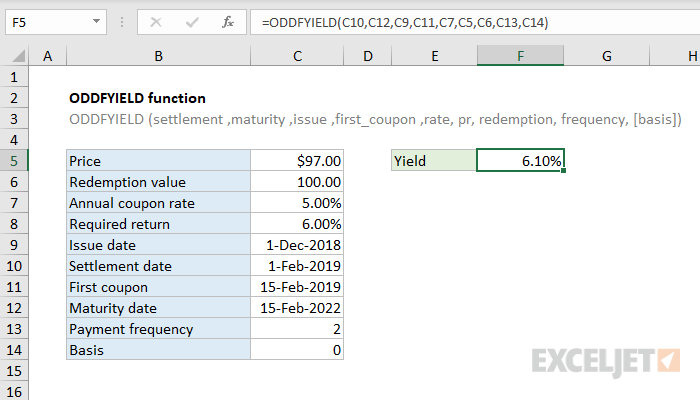Purpose
Return value
Syntax
=ODDFYIELD(sd,md,id,fd,rate,pr,redem,freq,[basis])- sd - Settlement date of the security.
- md - Maturity date of the security.
- id - Issue date of the security.
- fd - First coupon date.
- rate - Annual coupon rate of security.
- pr - Price of security.
- redem - Redemption value per $100 face value.
- freq - Coupon payments per year (annual = 1, semiannual = 2; quarterly = 4).
- basis - [optional] Day count basis (see below, default =0).
Using the ODDFYIELD function
Some bonds have an irregular first or last period, so interest payments don't fit a normal schedule. To calculate the yield of a bond with an irregular first period, you can use the ODDFYIELD function. The ODDFYIELD Function returns the yield (as a percentage) of a security with a short or long first period.
Example
In the example shown, we want to calculate the yield of a bond with a settlement date of 1-Feb-2019. The bond matures on 15-Feb-2022, and pays a coupon rate of 5%, with the first coupon paid on 15-Feb-2019. Payments are semi-annual, the day count basis is US 30/360, and the redemption value is $100. In the example shown, the formula in F5 is:
=ODDFYIELD(C10,C12,C9,C11,C7,C5,C6,C13,C14)
With these inputs, the ODDFYIELD function returns a yield of 6.10%, with the percentage number format applied.
Entering dates
In Excel, dates are serial numbers. Generally, the best way to enter valid dates is to use cell references, as shown in the example. To enter valid dates directly inside a function, the DATE function is the best option. To illustrate, the formula below has all values hardcoded, with the DATE function used for each of the four required dates:
=ODDFYIELD(DATE(2019,2,1),DATE(2022,2,15),DATE(2018,12,1),DATE(2019,2,15),0.05,97,100,2,0)
Basis
The basis argument controls how days are counted. The ODDFYIELD function allows 5 options (0-4) and defaults to zero, which specifies US 30/360 basis. This article on Wikipedia provides a detailed explanation of available conventions.
| Basis | Day count |
|---|---|
| 0 or omitted | US (NASD) 30/360 |
| 1 | Actual/actual |
| 2 | Actual/360 |
| 3 | Actual/365 |
| 4 | European 30/360 |
Notes
- In Excel, dates are serial numbers.
- All dates, plus frequency and basis, are truncated to integers.
- If dates are invalid (i.e. not actually dates) ODDFYIELD returns #VALUE!
- ODDFYIELD returns #NUM when:
- (maturity > first_coupon > settlement > issue) is NOT true
- Rate < 0 or pr <= 0
- Basis is out-of-range












